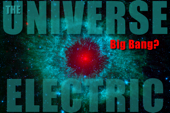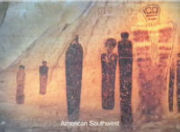Plasma - Is Not a Dirty Word
02/24/08
The field of plasma physics has much to teach us about how the natural world operates. However, some question the use of plasma physics where, due to prior assumptions, they believe that plasma does not carry current in space. It seems necessary to once again revisit the basics. What is a plasma? Where and under what temperature and ionization regimes can plasma be found? Is it more common than originally thought and if so what does that mean for physical models that fail to incorporate knowledge from laboratory experiments in plasma?
In a prior Thunderblog entry ( Is it Appropriate to Speak of Electric Currents in Space? ), I responded to a critic who had challenged the use of the terms “electricity” and/or “electric” when referring to any conductive medium other than metal wires.
This time around, in a friendly debate with someone who claims to be well-versed in the standard model’s physical and astronomical theories, it has been asserted to me that the term plasma only applies under certain very specific, very limited conditions.
These conditions being that the materials must be extraordinarily hot, and mostly or completely “charge separated” to the point where effects due to that charge separation take over. Anything below this fully ionized, fully “separated” threshold could not be termed “plasma,” according to this gentleman.
The question of what qualifies as “plasma,” and the proceeding assertion that only highly ionized and very hot materials can be termed as such, came out of a prior discussion in which I had referenced a chart from the Lawrence Livermore National Laboratory (LLNL) giving examples of various particle densities and temperatures associated (loosely) with specific entities or processes (neon signs, auroras, flames, lightning, fusion reactors, the sun’s core, the sun’s corona, etc.) which the LLNL page in question termed plasma.
In the course of our conversation, he asserted that neon signs and flames were controversial at best, if not outright incorrectly termed “plasma,” and should instead be termed “gas.” His assertion came from his understanding that A) the “gas” (his term) was too cold, insufficiently ionized, and gave off “neutral” lines in its spectrum.
From conversations I’ve been party to on the Thunderbolts.info forums and elsewhere, I was under the impression that flames of sufficient intensity were classed by many plasma physicists, and/or fusion researchers to be weakly-ionized, collisional plasmas (plasmas that under some circumstances act like ideal gases and under other circumstances develop behaviors and structures attributable only to plasma, such as carrying currents, forming double layers, etc.). Likewise, my understanding was that neon lights and fluorescent lights were essentially glow discharge tubes (electrical current passed through extremely sparse gases, ionizing portions of it and energizing it to the point of entering “glow discharge” mode). I didn’t realize these assumptions might be controversial until they were pointed out by someone claiming to understand physics, but whom was not aware that these processes were considered by anyone to be forms of “plasma.”
So, I decided to do a little bit of researching on my own, to see whether my understanding was valid. A self-check is a healthy thing in science. One can be wrong and not know it until it has been pointed out.
Defining plasma.
Both the Lawrence Livermore National Laboratory’s “Plasma Dictionary” and the Internet Plasma Physics Education Experience (IPPEX) site’s “Glossary of Fusion Terms” were adequate educational resources.
LLNL’s Plasma Dictionary entry on plasma
Known as the "Fourth State of Matter", a plasma is a substance in which many of the atoms or molecules are effectively ionized, allowing charges to flow freely. Since some 99% of the known universe is in the plasma state and has been since the Big Bang, plasmas might be considered the First State of Matter. Plasmas have unique physics compared to solids, liquids, and gases; although plasmas are often treated as extremely hot gases, this is often incorrect. Examples of plasmas include the sun, fluorescent light bulbs and other gas-discharge tubes, very hot flames, much of interplanetary, interstellar, and intergalactic space, the earth's ionosphere, parts of the atmosphere around lightning discharges, laser-produced plasmas and plasmas produced for magnetic confinement fusion. Types of plasmas include - Astrophysical, Collisionless, Cylindrical, Electrostatically Neutral, Inhomogeneous, Intergalactic, Interstellar, Magnetized, Nonneutral, Nonthermal, Partially Ionized, Relativistic, Solid State, Strongly Coupled, Thermal, Unmagnetized, Vlasov and more.
The article states “many of the atoms or molecules are effectively ionized, allowing charges to flow freely.” It doesn’t state that the plasma must be fully-ionized, or even mostly-ionized (50% or more). The article also intimates that considering plasmas to be merely “extremely hot gases” is often incorrect. Structures and behaviors other than those typically observed in “neutral gases” may be observed in plasmas. One key characteristic of plasma is that, due to freely flowing charge carriers, they are excellent conductors of electric currents (though not perfect conductors, nor necessarily superconductors).
The article goes on to note several specific examples of plasmas in deep and near space, here on Earth, and in our day-to-day lives. It states that interplanetary, interstellar and intergalactic space is filled with plasma (unbound electrons and protons, as well as positively or negatively charged ions of various atomic species make up those plasmas), that the sun (at the very least, the core and corona are considered by many to be “hot” enough that they are uncontroversially labeled plasma). On Earth, they intimate that lightning (and the directly adjacent region(s) in the atmosphere), much of the ionosphere (hence the name) and very hot flames are considered plasma. In daily life, they note that fluorescent lights and other gas discharge tubes (neon lighting, plasma lamps, etc.) also utilize plasma. In industrial applications, laser-generated plasma and plasmas used for fusion are (obviously) also considered plasmas.
In short, plasma exists over a number of temperature and ionization regimes, as will be seen later.
Important in understanding certain plasma interactions is the concept of “weakly-ionized,” or “partially-ionized” plasma. The LLNL article on weakly-ionized plasma says the following:
A plasma in which only a small fraction of the atoms are ionized, as opposed to a highly ionized plasma, in which nearly all atoms are ionized, or a fully ionized plasma, in which all atoms are stripped of all electrons nearly all the time. Even in a weakly ionized plasma, the dynamics of the system may be dominated by effects caused by the (relatively small) number of (relatively strongly interacting) ions and electrons, as opposed to the (relatively large) number of (relatively weakly interacting) neutrals.
Again, it appears to be reaffirmed that plasmas exist over a wide range of ionization states, from weakly-ionized (only a small fraction of the atoms are ionized), to highly-ionized (a large proportion of atoms are ionized), to fully-ionized (all atoms are stripped of all electrons most of the time).
However, even in weakly-ionized plasmas, it appears that the effects of a small percentage of strongly-interacting charged particles may dominate the effects of the much larger quantity of “neutral,” non-interactive atoms. Thus, the weakly-ionized bulk materials behave like a plasma more so than a “neutral gas,” on account of the neutral elements’ minimal contribution to the overall behavior of the medium.
To be sure that we’re not simply getting one institution’s interpretation, we can check alternate resources, such as the IPPEX Glossary of Fusion Terms entry on plasma or Wikipedia’s extensive article on plasma.
The IPPEX glossary definition of plasma once again affirms that things such as fluorescent lights and other gas discharge tubes (neon lights, plasma lamps, etc.), very hot flames and much of the ionosphere qualify as plasmas.
The Wikipedia article on plasma goes into greater detail on weakly ionized plasma, and various examples of plasmas in space, the atmosphere, and daily life.
Additional examples of places where plasmas occur include plasma TVs, arc welders, lightning, the auroras, St. Elmo’s Fire, sprites, ELVEs, blue jets, the IO-Jupiter flux tube, the solar wind, and large portions of the material in interplanetary, interstellar and intergalactic space.
With regard to “weakly-ionized plasma,” Wikipedia had the following to say:
The degree of ionization of a plasma is the proportion of atoms which have lost (or gained) electrons, and is controlled mostly by the temperature. Even a partially ionized gas in which as little as 1% of the particles are ionized can have the characteristics of a plasma (i.e. respond to magnetic fields and be highly electrically conductive).
So, far from any requirement of “high-ionization” or “full-ionization,” it seems that some plasmas as weak as 1% ionized can respond to magnetic fields and be highly electrically conductive.
With regard to plasma “temperature,” Wikipedia had the following to say:
Because of the large difference in mass, the electrons come to thermodynamic equilibrium among themselves much faster than they come into equilibrium with the ions or neutral atoms. For this reason the ion temperature may be very different from (usually lower than) the electron temperature. This is especially common in weakly ionized technological plasmas, where the ions are often near the ambient temperature.
[…]
A plasma is sometimes referred to as being hot if it is nearly fully ionized, or cold if only a small fraction (for example 1%) of the gas molecules are ionized (but other definitions of the terms hot plasma and cold plasma are common). Even in a "cold" plasma the electron temperature is still typically several thousand degrees Celsius. Plasmas utilized in plasma technology ("technological plasmas") are usually cold in this sense.
It appears that “cold plasma” is roughly synonymous with “weakly-ionized plasma” (where only a few of the atoms, as low as 1% in some cases, have been ionized) and “hot plasma” is roughly synonymous with “highly-ionized” or “fully ionized” plasma (where most or all of the atoms have been ionized or stripped of one or more electrons).
In fact, scholarship on the subject of sprites (upper-atmospheric discharges associated primarily with exceedingly strong “positive” cloud-to-ground lightning) indicates that the 1% ionization estimate for “cold” plasma is extremely conservative by several orders of magnitude:
The presence of free electrons in sprites in such dilute concentration--some 13 orders of magnitude less than that in lightning channels!--helps resolve the spectroscopic puzzle about the apparent absence of ionization in both the air-filled glow discharge tube and in the body of sprites. An electron density of 105 cm(-3) at an altitude of 70 km corresponds to fewer than one free electron for every 10 billion neutral nitrogen molecules. […] These considerations indicate that, although sprite plasma is so weakly ionized that it escapes spectroscopic detection, it can still strongly interact with electromagnetic radiation of sufficiently low frequency.
So, free electron densities of approximately one part in ten billion (1/(1010) is several orders of magnitude lower than 1% or 1/(102)) are effectively “invisible” to spectroscopy due to the extraordinarily weak ionization, and yet they are sufficient to dominate over the interactions of 10 billion times more “neutral” atoms in scripting the mass behavior of the particles in sprites. This may also be the reason why glow discharge tubes such as neon and fluorescent lights give off “neutral lines,” according to critics. The extremely weak ionization is effectively masked, despite being present and a prime mover and shaker!
It now seems apparent that it is, in fact, appropriate to utter the term “plasma” in the presence of such seemingly benign processes as neon lights, fluorescent lights, the polar auroras, the solar wind, static electricity (small sparks), lightning (big sparks), the ionosphere, and light, dusty, weakly- or strongly-ionized materials in interplanetary, interstellar and intergalactic space. It also thus appears appropriate to consider that the greatly outnumbered (but more strongly interacting) ionized species in those regions can and do sometimes overwhelm the far more numerous (but weakly interacting) “neutral” particles in determining group behavioral dynamics of those systems.
As such, it seems that some “old school” theories (based solely on mechanical ideal gas laws) may need a rethink in terms of modern understandings of plasma processes. Terminology likely needs to be re-assessed for consistency across multiple disciplines: physics, electrical engineering, astronomy, biology, et al. If we can all get on the same page with an understanding of the fundamental physics and terminology, perhaps we can make great strides in addressing pressing issues in the sciences. Communication and consistency across disciplinary lines (field lines, if you will) is a must, if we are to adequately understand one another and correctly communicate new discoveries.
One might be tempted to speculate on a few possible questions or implications based upon our new understanding of what can be classed as plasma phenomena, and the understanding that plasma is a highly conductive medium:
-
If the sun’s upper chromosphere and corona are composed of plasma, what would the effect be if electric currents were conducted through it. What specific identifiable behaviors or structures would it display?
-
If the sun “convects” as the standard model implies and the photosphere / chromosphere are too “cold” to be “fully-ionized,” is it possible that they are hot enough to be innately “partially-ionized” or “weakly ionized.” If not ionized thermally, what happens if ionized species (electrons, protons and ions) “convect” from above (corona / chromosphere) or below (the solar core)? Would the convection of said species be sufficient to consider the photospheric / chromospheric layers to be weakly- or partially-ionized (if not innately, then through convection of ionized species)?
-
If the chromosphere and/or photosphere are ionized (weakly or partially), must we then also consider the possibility of “[electric] currents” therein and their effects inside and outside of those layers?
-
If the solar wind is a diffuse plasma, can it carry current? If it can carry current, what identifiable behaviors or structures would we expect? Might those behaviors and structures provide a simple explanation for such things as “Birkeland currents,” “magnetic flux ropes” dumping energy directly from the sun into our polar auroras, proton beams in the solar wind (a “conventional [electric] current”) and the strahl (electron beams in the solar wind; also an electric current)?
------------------
* Note: Hannes Alfven recanted his notion of “frozen-in” magnetic field lines in plasma, emphasizing that where magnetic fields exist, one must consider their source electric currents (magnetic fields don’t stand alone in absence of current; even at the sub-atomic level, collective electron orbital motion is generally considered to give rise to the more “permanent” forms of magnetism). Alfven’s assertion reaffirms James Clerk Maxwell’s integrated interpretation of the electromagnetic field. As such, it is our position that “magnetized plasma” is a misnomer and fails to acknowledge the role of electric current in generating the magnetic field (where current flows, a magnetic field is generated; where no current flows, no magnetic field is generated).
Permalink to this article.
Public comment may be made on this article on the
Thunderbolts Forum/Thunderblogs (free membership required).
|

Michael Gmirkin is a technology enthusiast with a keen interest
in exploring the electrical nature of the universe.
My Archives
Chronological Archives
Archives by Author
Archives by Subject
Thunderblogs home
|




